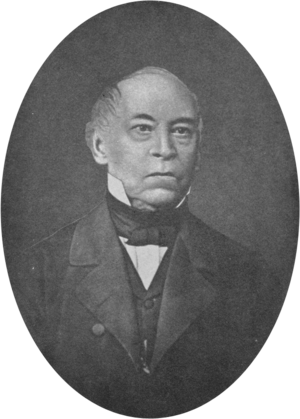Friedrich Christian Diez facts for kids
Friedrich Christian Diez (born March 15, 1794 – died May 29, 1876) was an important German philologist. A philologist is someone who studies languages, especially their history and how they change over time. Diez is famous for his two big books: the Grammar of the Romance Languages and the Etymological Dictionary of the Romance Languages. He spent most of his working life at the University of Bonn.
Contents
About His Life
Diez was born in Giessen, a town in Germany. He went to school there and then studied at the universities in Giessen and Göttingen. At Göttingen, he studied classic languages like Greek and Latin. His teacher, Friedrich Gottlieb Welcker, helped him discover a love for Italian poetry.
In 1813, Diez joined the army for a short time during a war with France. After that, he went back to his studies. This was the only time he stopped his long life of literary work.
How He Started Studying Languages
For a while, Diez studied law because his parents wanted him to. But in 1818, he visited a famous German writer named Johann Wolfgang von Goethe. Goethe had been reading about old French poetry. He told Diez to look into the rich world of Provençal literature. Provençal is an old language spoken in southern France.
Diez eagerly followed Goethe's advice. From then on, he focused on studying Romance languages. These are languages like French, Spanish, Italian, and Portuguese, which all came from Latin. Because of his work, Diez is known as the founder of Romance philology.
His Career and Main Works
For some years, Diez worked as a private teacher. In 1822, he moved to the University of Bonn. There, he became a "privatdozent," which is a kind of private lecturer.
In 1823, he published his first book, An Introduction to Romance Poetry. The next year, he wrote The Poetry of the Troubadours. Troubadours were poets and musicians from the Middle Ages who wrote in Provençal. In 1829, he published The Lives and Works of the Troubadours. In 1830, he became a professor of modern literature at the university.
Most of the rest of his life was spent writing his two most famous books. These were the Grammar of the Romance Languages (published between 1836 and 1844) and the Etymological Dictionary of the Romance Languages (published in 1853). In these books, Diez did for Romance languages what Jacob Grimm did for the Germanic languages, like German and English. He showed how they developed and how their words are related.
His Method of Study
Before Diez, many people just guessed where words came from. But Diez used a scientific method. He carefully studied how sounds and words changed over time in languages. He looked for patterns and rules. He believed in finding facts and arranging them. He said that this was the secret to his success. He was always ready to accept new facts, even if they changed his ideas.
His Important Books
Diez used this careful historical method in his grammar book and his dictionary.
The Grammar of Romance Languages
The introduction to his grammar book has two parts. The first part talks about the Latin, Greek, and Germanic parts that are common to all Romance languages. The second part looks at six different Romance dialects. It explains where they came from and what makes each one special.
The grammar book itself has four main sections:
- Phonology: This is about how sounds in words change.
- Flexion: This is about how words change their endings to show things like tense or number.
- Word Formation: This explains how new words are made by combining or changing existing words.
- Syntax: This is about how words are put together to form sentences.
The Etymological Dictionary
His dictionary is divided into two parts. The first part includes words that are found in at least two of the main Romance language groups. These groups are Italian and Romanian, Spanish and Portuguese, and Provençal and French. Italian words are usually listed first because Italian is closest to the original Latin.
The second part of the dictionary looks at words that are only found in one of these language groups. There isn't a separate section for Wallachian (an old name for Romanian) in the dictionary.
See also
 In Spanish: Friedrich Christian Diez para niños
In Spanish: Friedrich Christian Diez para niños


